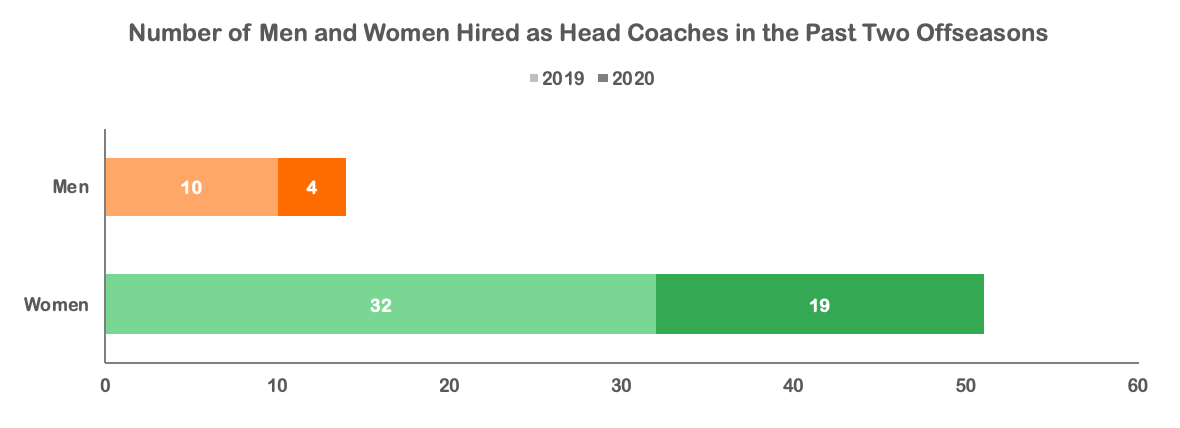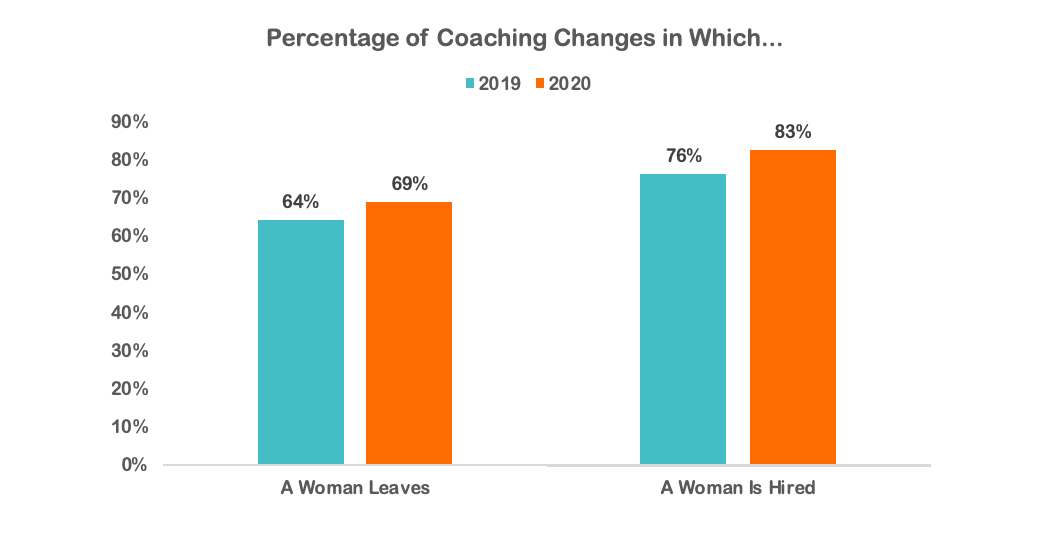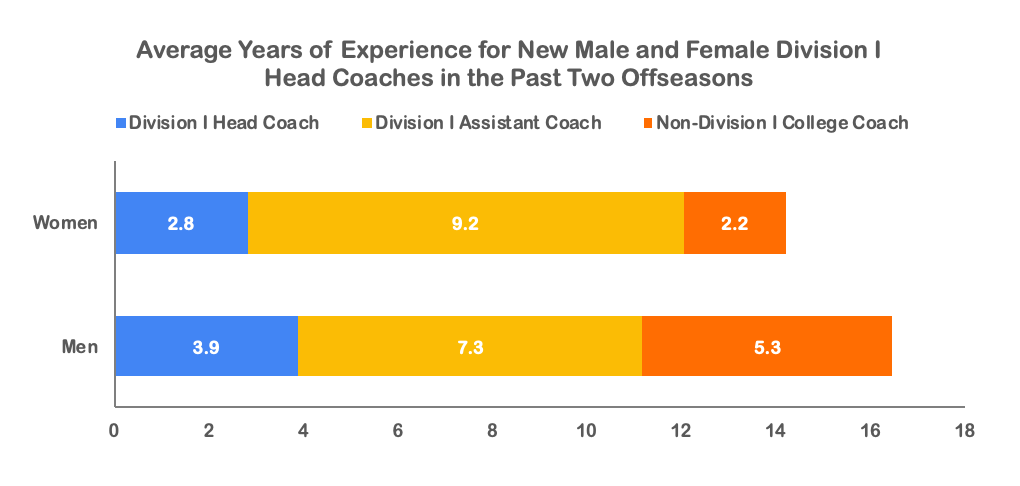Analyzing the Offseason Coaching Carousel in Women’s College Basketball: Part Two
Examining coaching changes from a gender equity perspective
Thanks for reading the Her Hoop Stats Newsletter. If you like our work, be sure to check out our stats site, our podcast, and our social media accounts on Twitter, Facebook, and Instagram. You can also buy Her Hoop Stats gear, such as laptop stickers, mugs, and shirts!
Haven’t subscribed to the Her Hoop Stats Newsletter yet?
Yesterday, I explored what the coaching carousel in Division I women’s college basketball has looked like this offseason and how that compares to 2019. In short, the 2020 offseason has seen less turnover among head coaches than in 2019, and this year’s coaching carousel started a little later than the 2019 iteration, which makes sense considering all of the unknowns the coronavirus pandemic has created.
Whereas Part One of this series focused on the number and timing of coaching changes, this article will dig into questions of gender equity in hiring. Are women being hired—and fired—at the same rates as men? Are enough women getting a first chance at being Division I head coaches? And does the amount and type of experience that successful female candidates have differ from what men need to get head coaching positions?
This data set was compiled using lists of head coaching changes from High Post Hoops (2019) and WBB Blog (2020), data from Her Hoop Stats, and information from team websites. These data reflect all coaching changes through May 24, 2020.
Athletic directors are hiring a lot of women!
In the past two offseasons, athletic directors have hired women for 78% of head coaching vacancies in women’s college basketball. In the graph below, the lighter bar represents the 2019 offseason and the darker bar represents the 2020 offseason.

As a result, the percentage of female head coaches in Division I women’s college basketball increased last season from 61% in 2018-19 to 63% in 2019-20. In fact, it has been steadily increasing since 2015-16, following several years of declines. The result was a net gain of five female head coaches in 2019, and in 2020, there will be another net gain if at least two of the six vacant positions go to women.
The growth in opportunities for women
Women have been overrepresented in new hires, but they have also been slightly overrepresented among coaches leaving a school. The good news for everyone who wants more women coaching women’s college basketball is that a higher share of women have been hired than have left in the past two offseasons.

In Part 1, I found no gender differences in the four main reasons why coaches left their jobs, so this high share of women leaving jobs is not necessarily indicative of bias. In fact, if we look at more specific reasons for leaving, 32% of women who left their jobs in the past two offseasons did so in order to take another job compared to just 8% of men. The overwhelming majority of those moves were for other Division I head coaching jobs, which further underscores the opportunities that women are getting.
Importantly, women are also getting chances at their first Division I head coaching job. In 2019, 26 of the 42 coaches hired had never previously been a Division I head coach, and 19 of those first-time head coaches were women. So far this offseason, 11 of 13 first-time head coaches are women, including Niele Ivey at Notre Dame, longtime assistant Amy Mallon at Drexel, and former Stanford player Lindy LaRocque at UNLV.
Most of these women are being hired with traditional experience
For women, playing college basketball appears to be an absolute prerequisite for coaching it: all 47 women hired in the past two offseasons have played college basketball at some level. However, the level at which they played seems to be less relevant. For every Carla Berube, who won a national championship with UConn in 1995 and became the Princeton head coach in 2019, there are also coaches who played at the junior college, Division II, or Division III level.
Former WNBA and ABL (American Basketball League, which operated from 1996 to 1998) players are also getting chances as head coaches. Fourteen of the 51 women hired in the past two offseasons (27%) have played professional basketball in the United States, including Nikki McCray-Penson (hired by Mississippi State), DeLisha Milton-Jones (Old Dominion), and Nicole Powell (UC Riverside) in 2020 alone. For half of those 14 women, it is their first Division I head coaching position.
On the other hand, just six of ten men hired in the past two offseasons had played college basketball, and none had played in the NBA. Whereas many of the women had taken what might be called “more traditional” paths—working their way up as Division I assistant coaches—the men were often hired with more experience as non-Division I college coaches.

Note: These data include experience coaching women’s college basketball only, not men’s college basketball or at the high school level. Any non-head coaching role was considered to be “assistant” for this exercise.
Perhaps reflecting differences in how athletic directors value each of those kinds of experience, women actually averaged 2.3 fewer years of overall college coaching experience than men.
In March 2019, then-Notre Dame head coach Muffet McGraw memorably said, “People are hiring too many men.”
If you believe that 100% of head coaches in women’s college basketball should be women, that statement is still true. But otherwise, perhaps the tide is turning, as women have been disproportionately hired in each of the past two coaching carousels. They also haven’t had to have more experience than men to be considered for the same jobs, though they are more likely to have played themselves and tend to have more experience coaching in Division I.
It remains to be seen what kind of legacies these new female coaches leave, but opening the door for them is an important first step. The coronavirus has impacted several aspects of the hiring process, as shown in Part One of this series, but fortunately, it does not appear to be hindering the growth of opportunities for women to coach Division I women’s college basketball.
Thanks for reading the Her Hoop Stats Newsletter. If you like our work, be sure to check out our stats site, our podcast, and our social media accounts on Twitter, Facebook, and Instagram.



